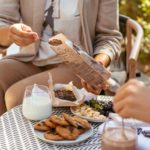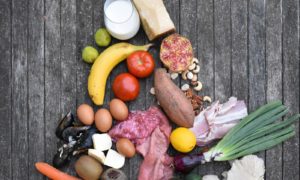Estimated reading time: 4 minute(s)
If you want to start off the year by taking care of your health, you must start by understanding what a balanced plate is made up of in order to follow a healthy diet. Knowing this will help us to better organize our meal plans and simplify our shopping lists. Making it easier not to stray.
Of course to follow a healthy diet we should eat natural and high quality foods, but it’s also key to balance out the nutrients that we are consuming throughout the day. In order to do this, it’s important to forget all those erroneous and obsolete concepts that have led us to believe that carbohydrates are the foundation of our diet rather than focusing on the importance of fruits, vegetables, and nuts which have been the basis of human nutrition for millions of years. This has been evident in the food pyramids that they’ve been selling us for years.
The New Natural Food Pyramid
In my book, “Change What You Eat And You Will Change The World” I suggest a different type of food pyramid, in which the well-being of people comes before the interests of an industry that sells “more profitable” food or so it’s thought, at first sight but in reality in the long run is much more expensive for our health.
The natural food pyramid has a solid base which is made up of one of my favorite food groups, vegetables and fruits (in this case the ones with the lowest amounts of starch and fructose, I’ll talk more about this later); followed by the next group of meats, poultry, fish and seafood, and eggs; then comes the group with nuts, seeds, and vegetables/fruits with higher amounts of starch and fructose; and lastly, at the top we have dairy products.

However, in this post I don’t want to focus on just speaking about the food pyramid, but rather how it can be used as a real and tangible tool to assist us in creating a more balanced plate.
Natural Athlete’s Balanced Plate

I thought it would be a good idea to give a general guide on how to structure your plate so that, at the end of the day, you have given your body all the nutrients it needs to function properly. Of course, this is not just a one size fits all, blanket solution. Not all of our meals should look like this, nor are we all the same. Rather this is just something to keep in mind of what an ideal meal looks like, but as with everything, we must adapt this to our own reality. At the end of this post, I’ve given you a one-day meal plan based around this concept, in the hope that you will see its practicality and better understand how you can apply this both at home and whenever you eat out.
So how do I get a balanced meal? The first thing is to make sure that each of its components cover the following : energize you, build tissues and regulate your body.
Energizing
Having enough energy in your body to carry out all its daily activities is vital, so including this kind of food in your diet will help improve performance and not force your body to run without fuel, as this would only exhaust you and in the future wear out your muscles. The Nutrients that provide us with energy are fats and carbohydrates; however, fats are healthier since they fill us up faster and for longer (which is ideal when trying to maintain and/or lose weight). Also, they do not cause spikes in blood sugar levels, unlike many carbohydrates (especially over-processed ones), which is important when controlling glycemia in the blood such as the case with Diabetes.
As a source of energy, I recommend the fats found in nuts and the flours derived from them as well as seeds, butter, avocado, and oils such as olive and coconut oil, but, always in their organic version. If you want to use a more natural sweetener that fits with a balanced and healthy lifestyle, I suggest using coconut sugar or raw honey, and always go for gluten-free carbohydrates and foods with low starch content like quinoa, buckwheat, tapioca flour and chestnut flour. Though, I generally suggest avoiding carbohydrates, (especially over-processed ones) since they are quickly digested which greatly increases glycemic spikes and makes us feel the urge to eat much sooner than necessary. It becomes a vicious never ending cycle.
Regarding portions, most of the fatty components are used in the process of making the dish, therefore, I’m not obsessed with them, the important thing is that my plate is balanced and is always a source of energy for my body; I would say that I try to have it fill up 20% of my plate
Building Tissues
Building (especially when it comes to children) and reparation (when you’ve been injured or suffered a blow) body tissue, like muscles and organs is a vital function of our bodies. Which is why it’s so important to include protein sources on our plate, such as red meat, poultry, fish, eggs, and dairy.
When talking about a naturally balanced plate, it’s important to differentiate between quality red meats such as pasture fed cows and those meats that are over-processed and are made up of a large amount of sulphites or those cows that have been given antibiotics or hormones. When it comes to dairy, try to always buy organic, and not skimmed or refined, it’s healthier and is richer in nutrients. You can also opt for fermented dairy like kéfir or yogurt, which are loaded with probiotics which help keep your intestine and body healthy. Proteins usually take up about 30% of my plate.
Regulating Your Body
The body is made up of various systems (digestive, muscular and nervous…) and ensuring that they are all functioning properly is vital to avoiding disease. The microscopic caretakers in charge of caring for our bodies are vitamins and minerals, which primarily come from fruits and vegetables. Making these, what should be the base of our diet and not cereal, pasta, rice and so on.
For my main meals, half of my plate is usually filled with vegetables, and although sometimes I prepare a salad where I throw in some fruit, I usually use fruit more as a snack or to prepare my smoothies because their carb content is usually higher. So, I try and avoid abusing them. Not all fruits and veggies are created equal. Bear in mind that some have a higher starch content such as bananas, squash, peas, beans, carrots, and cucumber (foods with a peel) so it’s important not to overeat these.
What I like most about the concept of the naturally balanced plate is its practicality, since it can be adapted to any situation or place. Whether you eat with what you have in the fridge or go out to eat, this concept allows you to select from many ingredients according to what’s available and the taste you’re looking for. The most important thing is that you are clear about what foods go in each group so that you are able to cover the three main functions of energizing your body , building and repairing tissues, and regulating your body.

For example, when I eat an appetizer and a main course, I look for the totality of both those dishes giving me the 3 main food groups; and if I’m unable to eat one of them that day, I make up for it the following day. The idea is that this tool is a guide NOT a prison. It’s important to stress that it’s NOT necessary for your plate to look like the one shown in the image. Rather it shows the portions of each food group that should be present on our plate. They can even be mixed together with other ingredients like, Sweet Potato Noodles with Peanut Butter Sauce and Quinoa Sushi with Peanut Butter or a Seaweed Salad.
Here is a one-day meal plan that fits the concept of our naturally balanced plate:
For Breakfast: A Bowl of Nuts & Seeds Granola with Fruit and Greek Yogurt
For Lunch: Zucchini Ravioli with Chicken Pesto
For Dinner: Quinoa Risotto with a fresh Salad
 #BeMoreNatural #SoloTieneCosasBuenas
#BeMoreNatural #SoloTieneCosasBuenas











